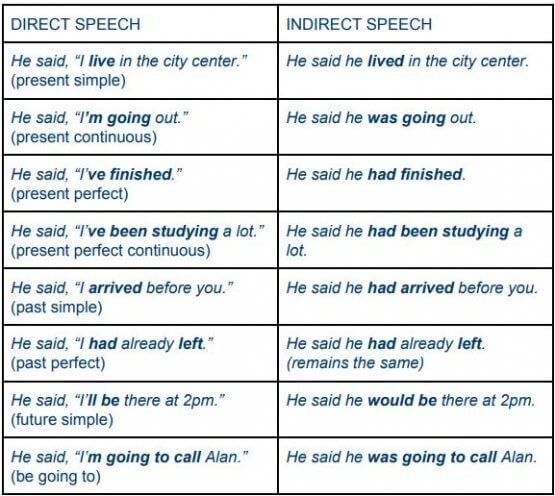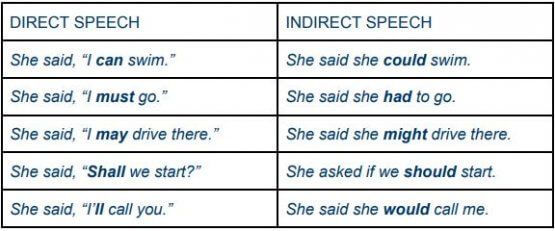Direct and indirect speech exercises
There are many occasions in which we need to describe an event or action that happened, and very often that includes repeating what someone said. Such occasions can include a social situation as well as in a work email or presentation. In order to describe what people said there are two different types of speech – direct speech and indirect speech (or reported speech).
Read the article below to find out more about these forms and improve your English storytelling skills.
Do you want to practice your English speaking skills with small classes with native-level teachers? Find out more about Speak+ now
Direct Speech
When we want to describe what someone said, one option is to use direct speech. We use direct speech when we simply repeat what someone says, putting the phrase between speech marks:
- Paul came in and said, “I’m really hungry.”
It is very common to see direct speech used in books or in a newspaper article. For example:
- The local MP said, “We plan to make this city a safer place for everyone.”
As you can see, with direct speech it is common to use the verb ‘to say’ (‘said’ in the past). But you can also find other verbs used to indicate direct speech such as ‘ask’, ‘reply’, and ‘shout’. For example:
- When Mrs Diaz opened the door, I asked, “Have you seen Lee?”
- She replied, “No, I haven’t seen him since lunchtime.”
- The boss was angry and shouted, “Why isn’t he here? He hasn’t finished that report yet!”
Indirect Speech
When we want to report what someone said without speech marks and without necessarily using exactly the same words, we can use indirect speech (also called reported speech). For example:
- Direct speech: “We’re quite cold in here.”
- Indirect speech: They say (that) they’re cold.
When we report what someone says in the present simple, as in the above sentence, we normally don’t change the tense, we simply change the subject. However, when we report things in the past, we usually change the tense by moving it one step back. For example, in the following sentence the present simple becomes the past simple in indirect speech:
- Direct speech: “I have a new car.”
- Indirect speech: He said he had a new car.
All the other tenses follow a similar change in indirect speech. Here is an example for all the main tenses:

The same rule of moving the tenses one step back also applies to modal verbs. For example:

Using ‘say’ or ‘tell’
As an alternative to using ‘say’ we can also use ‘tell’ (‘told’ in the past) in reported speech, but in this case you need to add the object pronoun. For example:
- He told me he was going to call Alan.
- They told her they would arrive a little late.
- You told us you’d already finished the order.
Changing Time Expressions
Sometimes it’s necessary to change the time expressions when you report speech, especially when you are speaking about the past and the time reference no longer applies. For example:
- Direct speech: “I’m seeing my brother tomorrow.”
- Indirect speech: She said she was seeing her brother the following day.
Here are some other examples:
- Direct speech: “I had a headache yesterday.”
- Indirect speech: You said you’d had a headache the day before yesterday.
- Direct speech: “It’s been raining since this afternoon.”
- Indirect speech: He said it’d been raining since that afternoon.
- Direct speech: “I haven’t seen them since last week.”
- Indirect speech: She said she hadn’t seen them since the previous week.
Reporting Questions
When you report a question you need to change the interrogative form into an affirmative sentence, putting the verb tense one step back, as with normal reported speech.
There are two types of questions that we can report – questions that have a yes/no response, and questions that begin with a question word like ‘what’, ‘where’, ‘who’ etc. When we report a yes/no question, we use ‘if’. For example:
- Direct speech: “Do they live here?”
- Indirect speech: You asked me if they lived here.
As you can see, in the reported version of the question, ‘do’ is eliminated because it is no longer a question, and the verb ‘live’ becomes ‘lived’.
For questions starting with question words like ‘what’, ‘where’, ‘when’, ‘who’, etc., we report the question using the question word but change the interrogative form to the affirmative form. For example:
- Direct speech: “Where do they live?”
- Indirect speech: You asked me where they lived.
- Direct speech: “When are you leaving?”
- Indirect speech: He asked us when we were leaving.
- Direct speech: “How will they get here?”
- Indirect speech: She asked me how they would get here.
When we report a question we normally use the verb ‘ask’. As with the verb ‘to tell’, the verb ‘to ask’ is normally followed by an object pronoun, though it is possible to omit it.
Reporting Orders and Requests
When you give someone an order, you use the imperative form, which means using just the verb without a subject. For example:
- “Call me back later.”
- “Have a seat.”
- “Don’t do that!”
To report an order we use ‘tell’ and the infinitive of the verb. For example:
- You told me to call you back later.
- He told me to have a seat.
- She told us not to do that.
When you make a request, you normally use words like ‘can’, ‘could’, or ‘will’. For example:
- “Could you call me back later?”
- “Will you have a seat?”
- “Can you not do that please?”
To report a request, we use the verb ‘to ask’ and the infinitive form of the verb. For example:
- You asked me to call you back later.
- He asked me to have a seat.
- She asked us not to do that.
Now you’ve seen how we use direct and indirect speech, practice using them yourself. An excellent and easy way to see how they are used is by reading a short story in English or a news article online, because stories and articles contain many examples of reported speech.
Of all the English verbs, the most important two are ‘to be’ and ‘to have’. Learn how to use them in this article.
When you learn phrasal verbs, it’s very helpful to know if they are transitive or intransitive. What do these words mean? Read on to find out more.
